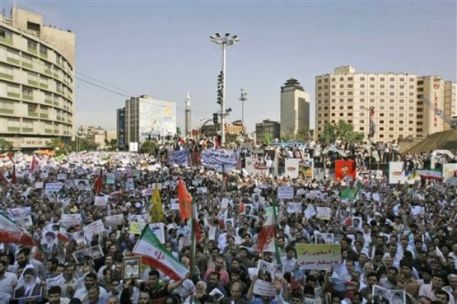Abusing the "R" Word in Iran

There has been a lot of speculation around the web and in print media as to whether or not what we're witnessing in Iran this week is the beginning of something bigger. We've even heard the "R" word get tossed around, as images of young Iranians marching and praising God in the streets of Tehran evoke images of 1979.
I would, however, advise a bit of caution in throwing the word "revolution" around, especially from an American perspective. The cynic in me would note that we've seen similar demonstrations and protests in Iran, most recently in 1999. Much like today, pundits and analysts were convinced then that street clashes between Iranian students and thuggish Hizballahis were the early indicators of something bigger to come. But that "something" never came, and the reform movement in Iran was subsequently thwarted and crushed.
It's also important to keep some perspective when comparing modern day Iran to the Iran of 1978 and 1979. While this week's demonstrations in Tehran have been impressive, they've yet to reach the range and level of participation as the national strikes and demonstrations of the Khomeinist revolution. As far as we can tell, the current upheaval is mostly isolated to Tehran. And while the many thousands marching on behalf of Mir Hossein Mousavi's election challenge are indeed awe-inspiring, they do not come close to the numbers reached during the Iranian Revolution, when anywhere between 25-30 cities per day were consumed by riots and upheaval. It's believed that nearly 10% of the Iranian population participated in those demonstrations at their height*, which is simply unheard of in the history of popular protest.
Of course, the "Green" revolution could grow. But it will take a lot more than Twitter and western hubris to make it so. Most Iranians have no idea what a 'Tweet' is, and these aspiring revolutionaries will need the nation's clerical class to assist them in turning the tide of public opinion. It looks as though that may be happening.
But even if this isn't the dawn of a revolution, it can still be something pretty inspiring and hopeful. It took Ayatollah Khomeini nearly two decades to build the popular movement that would eventually overthrow the Shah. There were protests and crackdowns dating back to the Kennedy administration. They enjoyed small victories, followed by crushing defeats. These things don't happen overnight.
But the important takeaway point is that the dedicated young men and women we see today seem ready to inherit a country that is rightfully theirs. It's often said that Khomeini's formative years came at the receiving end of Mohammad Reza Pahlavi's repressive and anti-Islamic policies. Mahmoud Ahmadinejad's formative years came during the hostage crisis and the Iran-Iraq War.
For the kids getting pummeled in the streets of Tehran this week, this is their formative moment. Much like the revolutionaries who preceded them, these young Iranians will remember the crack of the state's billy clubs, and the dismissive remarks of a Supreme Leader indifferent to their cries for fairness and freedom. Washing away the stains of Mossadeq and the wrongs of Jimmy Carter, these Iranians will have a new reason to someday reform their country.
It may not be the "R" word of our preference, but it's comforting nonetheless.
* As written by Charles Kurzman in his book "The Unthinkable Revolution in Iran"
---
All photos credit: AP Photos



